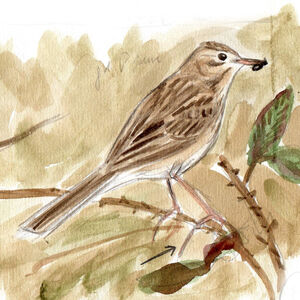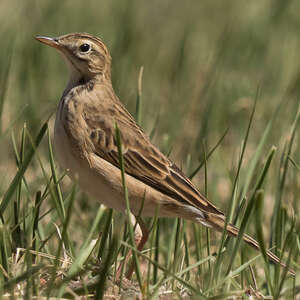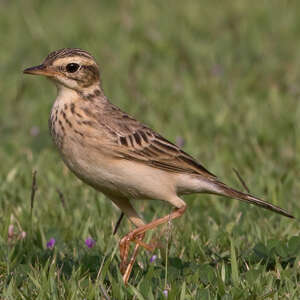Richard's Pipit
Anthus richardi - Pipit de Richard
Identification
Richard's Pipit is a large East Asian pipit which, in principle, has nothing to do with the West - yet evidence shows that some of the wintering birds from the nominate subspecies richardi have pushed further west, as far as France.
Richard's Pipit is larger than the Meadow Pipit and more robust, with a haughty look brought about by its head carriage, and its bill held upwards. Five subspecies are described that differ very little amongst themselves. Here I will describe the nominate subspecies richardi which is relevant to us.
There is no sexual dimorphism. The upperparts of the adult are brown-beige and streaked dark brown. The creamy-white tips of the medium coverts, which are themselves very dark, form a pale wing bar. The greater coverts, tertiaries and central rectrices are broadly edged with rufous-ochre. The two outer pairs of rectrices are white on their outer web, which is especially evident in flight.
The underparts are creamy-rufous, with the flanks being the reddest. The upper part of the chest has clear blackish-brown streaks against a rufous background, connecting to two patches of the same colour at the base of the neck.
The head, held high with its bill raised, is remarkable for its wide, whitish-creamy rufous eyebrow which borders the dark crown. The eye appears to have glasses of clear colour, contributed by the eyebrow, the white eyering, the lore and the pale subocular space. The auricular coverts are brown-ochre beneath a postocular line of brown. A brown moustache emphasises these coverts. Just below, a wide creamy sub moustachial streak corresponds to the eyebrow. It is emphasised by a thin blackish-brown malar line that runs from the bill to the dark patch at the base of the neck. The throat is whitish-creamy rufous.The lower mandible is pink, sometimes rather yellow. The toes and fingers are pink. The nail of the hind finger is very long (approx. 2 cm), longer than the finger itself. The juvenile can be recognized by its more contrasting plumage, with a scaly appearance on the upper parts, lost by autumn.
Richard's Pipit can easily be confused with Godlewski's Pipit to the east of the continent, but not in Europe where the latter does not come. It is necessary to look at the beak (shorter and more pointed in Richard's Pipit), the rear nail (shorter than the finger and more curved, < 1.5 cm) and the median covers (the brown-black of the center of the feathers ends in round).
Subspecific information monotypic species
Foreign names
- Pipit de Richard,
- Bisbita de Richard,
- petinha-grande,
- Spornpieper,
- sarkantyús pityer,
- Grote Pieper,
- Calandro maggiore,
- större piplärka,
- Tartarpiplerke,
- ľabtuška veľká,
- linduška velká,
- Storpiber,
- isokirvinen,
- piula de Richard,
- Vingultittlingur,
- świergotek szponiasty,
- lielā čipste,
- ostrožna cipa,
- Конёк Ричарда,
- マミジロタヒバリ,
- 理氏鹨,
- นกเด้าดินทุ่งใหญ่,
- 大花鷚〔理氏鷚〕,
Voice song and call
Habitat
Richard's Pipit is a bird found in cultivated and uncultivated, wet or dry, lowland and mountain habitats. It prefers grassy steppes, marshy margins and uncultivated agricultural land, etc. It is not very hard to find. In the winter, it frequents the same habitats, with a greater proportion of agricultural areas, like rice paddies and undisturbed stubble fields... The French wintering site on the edge of Crau can be considered a semi-arid steppe.
Behaviour character trait
This is a very down-to-earth bird and the majority of its activity takes place on the ground. It is quite shy.
Anxious, it stands on its long legs, stretching his neck, to search for danger. If forced, it flies off with its characteristic rolling call and will rest further away. It is important to know its call if specifically searching for it.If searching for it in France, for example in Crau, it is late in the Autumn, at a time when the Meadow Pipit is no longer present, making identification easier.
Dietfeeding habits
Reproduction nesting
We know very little. The breeding season goes from April to July, which leaves time for a second clutch, or even a third. The male sings in flight like all pipits, with the song being emitted in the final descending phase of the flight. The nest is built on the ground, hidden in a clump of grass. It is made of dry grass, stems and fine roots for the lining. The laying is of 3-4 eggs but the fine chronology of events is unknown.
Geographic range
Richard's Pipit's breeding range extends from southwestern Siberia and northeastern Kazakhstan to the extreme southeast of Russia, all the way through southern Russia, Mongolia and three-quarters of northern and northeastern China to the Pacific coast. It does not breed in the Korean Peninsula or Japan. It winters in India, Indochina and the extreme south of China. Part of the population of the nominate subspecies migrates to Southwest Asia and the Middle East and some adventurous migrants reach as far as the Atlantic coast of western Europe, where they stop. There is a regular wintering ground for a few individuals in a steppe-like site in southern France (Crau), which must appeal to them.
Threats - protection
Sources of information
- IOC World Bird List (v15.1), Gill, F and D Donsker (Eds). 2025-12-07.
- Les passereaux d'Europe, tome 1, P. Géroudet, M. Cuisin
- Pipits and Wagtails of Europe, Asia and North America, Alström Per and Mild Krister
- Birds of the World, The Cornell Lab of Ornithology
- xeno-canto, Sharing bird sounds from around the world,
Other sources of interest
 Specification sheet created on
27/07/2023 by Jean François
Specification sheet created on
27/07/2023 by Jean FrançoisTranslation by AI Oiseaux.net
© 1996-2026 Oiseaux.net
- Accipitriformes
- Aegotheliformes
- Anseriformes
- Apodiformes
- Apterygiformes
- Bucerotiformes
- Caprimulgiformes
- Cariamiformes
- Casuariiformes
- Charadriiformes
- Ciconiiformes
- Coliiformes
- Columbiformes
- Coraciiformes
- Cuculiformes
- Eurypygiformes
- Falconiformes
- Galliformes
- Gaviiformes
- Gruiformes
- Leptosomiformes
- Mesitornithiformes
- Musophagiformes
- Nyctibiiformes
- Opisthocomiformes
- Otidiformes
- Passeriformes
- Pelecaniformes
- Phaethontiformes
- Phoenicopteriformes
- Piciformes
- Podargiformes
- Podicipediformes
- Procellariiformes
- Psittaciformes
- Pterocliformes
- Rheiformes
- Sphenisciformes
- Steatornithiformes
- Strigiformes
- Struthioniformes
- Suliformes
- Tinamiformes
- Trogoniformes





























